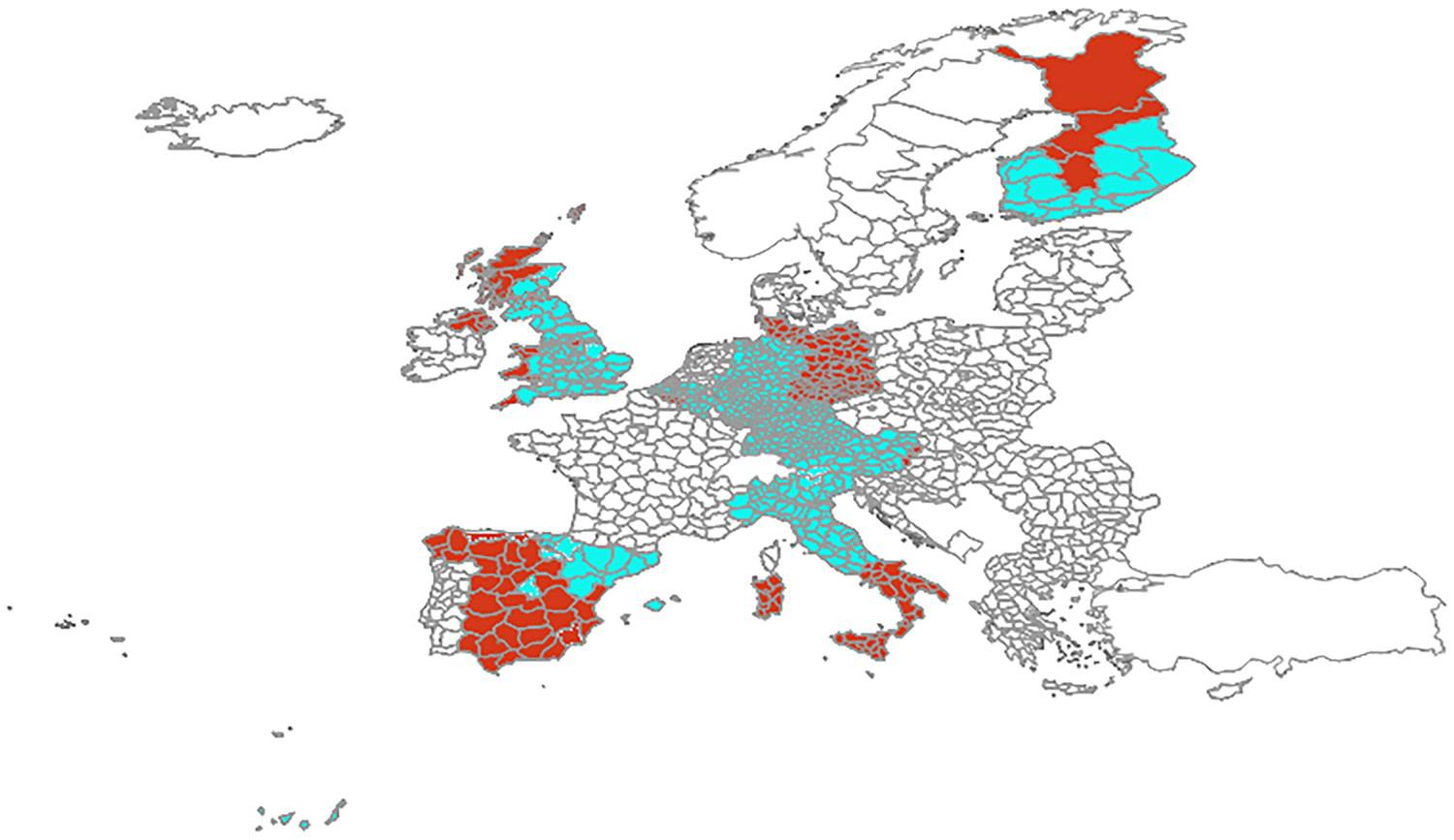Political debates on the post-2020 EU Budget have called into question the justification of Cohesion Policy as an EU-level policy. The (possible) departure of the UK – a net contributor to the EU budget – from the EU, together with mounting pressures from nationalistic and Eurosceptic parties in many member states, has forced a reconsideration of the value added of all EU policies. This debate has peaked with the proposal to renationalise Cohesion Policy in order to “drop some pan-European policies and ‘do less more efficiently’”, as European Commission President Jean-Claude Juncker put it (Beesley 2017).
While Cohesion Policy has survived the perilous waters of the new EU budgetary cycle, two fundamental questions remain unanswered.
- Has it produced a positive EU-wide impact on beneficiary regions over and above what would have happened without the policy?
- Do all member states benefit from it, or are regional impacts persistently diversified along national lines?
If positive EU-wide impacts are simply not there, then the evidence would support the critical views on the value added of the policy. Conversely, if pan-European effects do emerge but beneficiary regions gain only in some countries (and not in others), this would suggest that the policy per se does work, and that differences in priorities, implementation, and administration across member states fundamentally change the final outcome.
Most of the existing studies that employ counterfactual techniques in order to identify the impacts of Cohesion Policy conclude that the policy has a positive effect on growth and employment (see Crescenzi and Giua 2017 for a complete review). These same studies also suggest that the positive effects are contingent upon a number of local and policy conditions (such as the absorptive capacity of funds; see Becker et al. 2013). However, all of this evidence is only valid for the EU as a whole, with no insights into the country-specific nature of the estimated impacts; they tell us nothing about the heterogeneity of estimated impacts across countries, or the possible composition effects masked by EU-wide ‘average’ estimates.
Our recent paper (Crescenzi and Giua 2019) aims to fill this gap by applying counterfactual methods to estimate how economic the impacts of Cohesion Policy vary across countries, unveiling if (and to what extent) the regions of some member states benefit from the policy persistently more than others. We rely on a spatial regression discontinuity design (RDD), leveraging as thresholds for the treatment the spatial boundaries (policy-change boundaries) between Objective 1 regions (treated) and non-Objective 1 regions (non-treated). Following this approach, different thresholds can be identified in each country with Objective 1 and non-Objective 1 regions. This allows us to construct different counterfactual scenarios in different countries and to reproduce the same identification strategy in each country while preserving EU-wide comparability of the results. Using this RDD approach, we compare economic outcomes (economic growth and employment) of the treated and non-treated NUTS3 regions for each country, matched according to their geographical coordinates (Figure 1).
In contrast to existing RDD studies that could only estimate a single EU-wide ‘impact’ coefficient (leveraging the eligibility threshold of a regional GDP below 75% of the EU average GDP) or single-country studies that offer hard-to-compare estimates (e.g. Barone et al. 2016 and Giua 2017 on Italy; Criscuolo et al. 2019 and Di Cataldo 2017 on the UK), our innovative spatial RDD approach allows us to ‘unpack’ the aggregate impact of Cohesion Policy and estimate individual fully comparable coefficients for Germany, Italy, Spain, and the UK both before and after the Great Recession. By using the spatial RDD to net out the estimations from any confounding factors influencing the policy’s impact within a country, any differences in the estimated coefficients across member states can be ascribed to country-specific aspects related to national-level – as opposed to regional – specificities in quality of governance and/or implementation models.
Figure 1 Country-specific counterfactual scenarios
Source: Authors’ elaboration on Eurostat and European Commission data.
Note: Treated NUTS-3 regions (belonging to Objective 1 regions according to the 2000-2006 Cohesion Policy eligibility criteria) in red. Counterfactual NUTS-3 regions in green.
Cohesion Policy has exerted a positive and significant EU-wide impact on both regional economic growth and employment. The positive impact on regional employment has survived the Great Recession and supported less developed regions in the recovery period. However, the positive effects are not evenly distributed across the regions of all member states, with a large part of the regional growth bonus from Cohesion Policy concentrated in Germany and impacts on regional employment largely confined to the UK. The picture for Southern European member states is much less rosy. Italian beneficiary regions experienced better employment performance, but this effect ended with the Great Recession. Conversely, Spanish beneficiary regions only benefited from Cohesion Policy in terms of better growth performance during the recovery phase after the Great Recession, with no relief for structural unemployment problems.
Although the Barca Report (Barca 2009) recentred the debate on Cohesion Policy around the importance of highly localised factors conditioning success and failure, these results show that macro-national factors remain central. Macro-institutional conditions and models of intervention make more of a difference, in terms of impacts, than the diversity of local conditions. Early strategic decisions – such as the early focus on innovation in Germany or on skills in the UK – have significant long-term consequences and are better taken at the national level with more complete information and foresight capabilities as well as more effective coordination. However, while the predicaments of the Barca Report (and the adoption of a bottom-up approach) have resulted in a stronger role (and greater independence) being given to individual regions in the selection of the tools and the implementation of the policy, the same is not true for member states.
Would giving more flexibility and autonomy to the member states reinforce the economic impacts of Cohesion Policy? Our findings suggest that both models of intervention and economic impacts are already highly heterogeneous across countries. A nation-based approach – with better adaptation of the policy to the needs and overarching objectives of each individual member state – might be the best complement (and indeed, a much-needed counterbalance) to the current place-based approach. More national-level adaptability and autonomy might be the best response to the calls for re-nationalisation of key EU policies. While in the post-Brexit Europe territorial cohesion remains an EU-wide public good – requiring EU-wide coordination and financial solidarity – the most effective (and politically viable) approach to its achievement might be premised on a stronger role being (re)assigned to member states. Some national models of intervention are indeed effective and impactful, while others are not. Where performance is more disappointing, member states should take full responsibility and be empowered to act accordingly. This would also counteract the ‘blame Brussels’ rhetoric that has dominated the campaign for the 2019 European elections in many countries.
Member states cannot blame ‘Brussels’ (and its rules) if they see limited impacts in their less developed regions; this often reflects inappropriate national-level strategic choices. Conversely, there is a lot to learn from other member states on how to use the flexibility allowed for by Brussels in order to improve impact. The relevance of national-level impact heterogeneity (that persists over and above any other confounding factor ‘netted out’ by our spatial RDD strategy) suggests that members states can be given more freedom to choose how to invest Cohesion Policy money in exchange for more accountability (i.e. stopping blaming either their regional governments or Brussels for their own national choices), more transparent evidence-based strategic decisions, and robust evaluation procedures.
References
Barca, F (2009), An agenda for a reformed Cohesion Policy, Independent Report prepared at the request of Danuta Hubner, Commissioner for Regional Policy.
Barone G, F David, and G de Blasio (2016), “Boulevard of broken dreams. The end of EU funding (1997: Abruzzi, Italy),” Regional Science and Urban Economics 60(C): 31-38.
Becker, S O, P H Egger and M von Ehrlich (2013), “Absorptive capacity and the growth and investment effects of regional transfers: A regression discontinuity design with heterogeneous treatment effects”, American Economic Journal 5(4): 29–77.
Beesley, A (2017), “Juncker edges away from principle of ever closer union”, Financial Times, 1 March.
Criscuolo, C, R Martin, H G Overman and J Van Reenen (2019), “Some causal effects of an industrial policy”, American Economic Review 109(1): 48–85.
Crescenzi, R and M Giua (2017), “Different approaches to the analysis of the EU Cohesion Policy. Leveraging complementarities for evidence-based policy learning”, in J Bachtler, P Berkowitz, S Hardy and T Muravska (eds), EU Cohesion Policy. Reassessing performance and direction, Routledge: 21–32.
Crescenzi, R and M Giua (2019), “One or many Cohesion Policies of the European Union? On the differential economic impacts of Cohesion Policy across member states”, Regional Studies, forthcoming (advanced access).
Di Cataldo, M (2017), “The impact of EU objective 1 funds on regional development: Evidence from the U.K. and the prospect of Brexit”, Journal of Regional Science 57(5): 814–839.
Giua, M (2017), “Spatial discontinuity for the impact assessment of the EU Regional policy. The case of the Italian Objective 1 regions”, Journal of Regional Science 57(1): 109-131.




